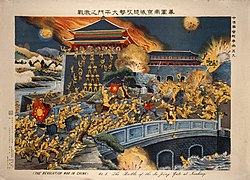Bourgeois revolution
You can helpexpand this article with text translated fromthe corresponding articlein Spanish.(November 2018)Click [show] for important translation instructions.
|
| Part ofa serieson |
| Political revolution |
|---|
 |
|
|
Bourgeois revolutionis a term used inMarxisttheory to refer to asocial revolutionthat aims to destroy afeudal systemor its vestiges, establish the rule of thebourgeoisie,and create abourgeois (capitalist) state.[1][2]In colonised or subjugated countries, bourgeois revolutions often take the form of a war of nationalindependence.TheDutch,English,American,andFrenchrevolutions are considered the archetypal bourgeois revolutions,[3][4]in that they attempted to clear away the remnants of the medieval feudal system, so as to pave the way for the rise ofcapitalism.[1]The term is usually used in contrast to "proletarian revolution",and is also sometimes called a"bourgeois-democratic revolution".[5][6]
Theories of bourgeois revolution[edit]

According to one version of thetwo-stage theory,bourgeois revolution was asserted to be a necessary step in the move towardsocialism,as codified byGeorgi Plekhanov.[7][8]In this view, countries that had preserved their feudal structure, likeRussia,would have to establish capitalism via a bourgeois revolution before being able to wage a proletarian revolution.[9][10]At the time of theRussian Revolution,theMensheviksasserted this theory, arguing that a revolution led by bourgeoisie was necessary to modernise society, establish basic freedoms, and overcome feudalism, which would establish the conditions necessary for socialism.[9]This view is prominent inMarxist-Leninistanalysis.[11][12]
Political sociologistBarrington Moore Jr.identifiedbourgeois revolutionas one of three routes from pre-industrial society to the modern world, in which a capitalist mode of production is combined with liberal democracy. Moore identified the English, French, and American revolutions as examples of this route.[13]
Neil Davidsonbelieves that neither the establishment of democracy or the end of feudal relations are defining characteristics of bourgeois revolutions, but instead supportsAlex Callinicos' definition of bourgeois revolution as being those that establish "an independent center ofcapital accumulation".[6][14][15]Charles Post labels this analysis asconsequentialism,where there is no requirement of the prior development of capitalism or bourgeois class agency for bourgeois revolutions, and that they are only defined by the effects of the revolutions to promote the development of capital accumulation.[16]
Other theories describe the evolution of the bourgeoisie as not needing a revolution.[17]TheGerman bourgeoisieduring the1848 revolutiondid not strive to take command of the political effort and instead sided with the crown.[18][19]Davidson attributes their behaviour to the late development of capitalist relations and uses this as the model for the evolution of the bourgeoisie.[20]
Left communistsoften view the revolutions leading tocommunist statesin the twentieth century as "bourgeois revolutions".[21][22]
The goals of the bourgeois revolution[edit]
According to the Marxist view, the tasks of the bourgeois revolution include:
- The creation of thenation state(which can be constituted differently in different peoples).[23][24]
- The constitution of thestateon the basis ofpopular sovereignty(therule of lawis based on aconstitution[25]adopted by the people).
- Bourgeois rule[26]if possible in the form of ademocraticrepublic[27][28](which, however, already found its complement in tyranny inantiquity).[29]
- The abolition ofserfdom,and the formation of freewage workers instead.[30][31]
- The separation of producers from themeans of productioninprimitive accumulation.[32]
- The abolition of theguildsand freedom ofinvestment.[30]
- The free development of theproductive forcesuntil they are ripe forsocial revolution.
Bourgeois revolutions in history[edit]
Bourgeois revolutions in the middle ages[edit]
Although with much less diffusion, some social movements of the EuropeanLate Middle Ageshave also received the name of bourgeois revolution, in which the bourgeoisie begins to define itself in the nascent cities as a social class. Examples include theCiompi Revoltin theRepublic of Florence,Jacquerie revoltsduring theHundred Years' Warin France,[33]andBourgeois revolts of Sahagúnin Spain.[34][35]
Bourgeois revolutions in the early modern period[edit]
The first wave of bourgeois revolutions are those that occurred within theearly modern periodand were typically marked by being driven from below by thepetty bourgeoisieagainstabsolutistgovernments.[6]

 German Peasants' War(1524–1525) (it has been labelled by later historians as an early attempt at a bourgeois revolution)[36]
German Peasants' War(1524–1525) (it has been labelled by later historians as an early attempt at a bourgeois revolution)[36] Eighty Years' War,also known as the Dutch revolution, (1566–1648)[3][37]
Eighty Years' War,also known as the Dutch revolution, (1566–1648)[3][37] English Revolution(1640–1660)[3][4][6]
English Revolution(1640–1660)[3][4][6] American Revolution(1765–1783)[3][6]
American Revolution(1765–1783)[3][6] French Revolution(1789–1799)[38][3]
French Revolution(1789–1799)[38][3] Irish Rebellion of 1798[39]
Irish Rebellion of 1798[39]
Bourgeois revolutions in the late modern period[edit]

The second wave of bourgeois revolutions are those that occurred within thelate modern periodand were typically marked by being led from above by thehaute bourgeoisie.[6]
 Greek Revolution(1821-1829)[40]
Greek Revolution(1821-1829)[40] July Revolution(1830)[41]
July Revolution(1830)[41] February Revolution(1848)[42][43]
February Revolution(1848)[42][43] German revolutions of 1848–1849[44]
German revolutions of 1848–1849[44]Revolutions of 1848 in the Italian states[45][43]
 Hungarian Revolution of 1848[45][46]
Hungarian Revolution of 1848[45][46] Risorgimento(1848–1871)[47]
Risorgimento(1848–1871)[47] Unification of Germany(1866–1871)[47]
Unification of Germany(1866–1871)[47] American Civil War(1861–1865)[48]
American Civil War(1861–1865)[48] Japanese Revolution(1868–1869)[49][47]
Japanese Revolution(1868–1869)[49][47] Philippine Revolution(1896–1898)[50]
Philippine Revolution(1896–1898)[50] 1905 Russian Revolution(1905–1907)[51][6]
1905 Russian Revolution(1905–1907)[51][6] Persian Constitutional Revolution(1905–1911)[52]
Persian Constitutional Revolution(1905–1911)[52] Young Turk Revolution(1908)[53]
Young Turk Revolution(1908)[53] Chinese revolution of 1911(1911–1912)[54][6]
Chinese revolution of 1911(1911–1912)[54][6] Mexican Revolution(1910–1917)[55]
Mexican Revolution(1910–1917)[55] February Revolution(1917) (called a "bourgeois-democratic revolution" in Soviet historiography)[56][57]
February Revolution(1917) (called a "bourgeois-democratic revolution" in Soviet historiography)[56][57] /
/ Chinese revolution(1925–1953)[58][21]
Chinese revolution(1925–1953)[58][21] Iranian Revolution(1978–1979) (according toEnver Hoxha)[59]
Iranian Revolution(1978–1979) (according toEnver Hoxha)[59]
References[edit]
- ^ab"Bourgeois Revolution".TheFreeDictionary.Archived fromthe originalon 21 September 2022.Retrieved6 November2018.
- ^Johnson, Walker & Gray (2014),p. 118;Calvert (1990),pp. 9–10;Hobsbawm (1989),pp. 11–12
- ^abcdeEisenstein (2010),p. 64, quoted inDavidson, Neil(2012). "From Society to Politics; From Event to Process".How Revolutionary Were the Bourgeois Revolutions?.Chicago, Illinois:Haymarket Books.pp. 381–382.ISBN978-1-60846-067-0.
- ^abCallinicos 1989,pp. 113–171.
- ^Wilczynski, Jozef, ed. (1981). "Bourgeois Revolution".An Encyclopedic Dictionary of Marxism, Socialism and Communism.London:Macmillan Press.p. 48.doi:10.1007/978-1-349-05806-8.ISBN978-1-349-05806-8.
- ^abcdefghDavidson, Neil(May 2012)."Bourgeois Revolution and the US Civil War".International Socialist Review.No. 83. Center For Economic Research and Social Change. Archived fromthe originalon 27 December 2021.
- ^Post 2019,pp. 157–158.
- ^Plekhanov, Georgi(1949) [1895].The Bourgeois Revolution: The Political Birth of Capitalism.Archived fromthe originalon 1 September 2018 – viaMarxists Internet Archive.
- ^ab"Stagism".Encyclopedia of Marxism.Archived fromthe originalon 1 December 2017.Retrieved6 November2018– viaMarxists Internet Archive.
- ^Lane, David (22 April 2020)."Revisiting Lenin's theory of socialist revolution on the 150th anniversary of his birth".European Politics and Policy.London School of Economics.Archived fromthe originalon 3 May 2020.
- ^Caputo, Renato."Grandezza e limiti della rivoluzione borghese in Marx"[Magnitude and limits of the bourgeois revolution in Marx].La Città Futura(in Italian). Archived fromthe originalon 6 March 2023.Retrieved6 March2023.
- ^Cervelli, Innocenzo (1976)."Sul concetto di rivoluzione borghese"[On the concept of bourgeois revolution].Studi Storici(in Italian).17(1): 147–155.JSTOR20564411.Retrieved6 March2023.
- ^Calvert 1990,pp. 53–55.
- ^Gluckstein, Donny (7 October 2013)."Comment on bourgeois revolutions".International Socialism(140). Archived fromthe originalon 18 May 2017.
- ^Post 2019,pp. 160–161, 166–167.
- ^Post 2019,pp. 160–161.
- ^Blackbourn, David.Economy and Society: A Silent Bourgeois Revolution.pp. 176–205. Archived fromthe originalon 21 February 2023.inBlackbourn & Eley (1984)
- ^Hallas (1988),pp. 17–20;Klíma (1986),pp. 93–94;Calvert (1990),pp. 53–55
- ^Blackbourn, David.Economy and Society: The shadow side.pp. 206–237. Archived fromthe originalon 21 February 2023.inBlackbourn & Eley (1984)
- ^Davidson, Neil(2012). "Marx and Engels (2) 1847–52".How Revolutionary Were the Bourgeois Revolutions?.Chicago, Illinois:Haymarket Books.p. 144.ISBN978-1-60846-067-0.
In a world where most states have not yet experienced bourgeois revolutions, where most are even more economically underdeveloped than Germany, they too will give rise to "belated" bourgeoisies, the implication being that it is Germany rather than France that represents the likely pattern of bourgeois development.
- ^ab"China: The bourgeois Revolution has been accomplished, the proletarian Revolution remains to be made".Communist Program(3). May 1977. Archived fromthe originalon 10 October 2023 – via International Library of the Communist Left.
- ^Post 2019,pp. 164–165.
- ^Marx & Engels 1956,8,p. 197.
- ^Marx & Engels 1956,16,p. 157.
- ^Marx & Engels 1956,37,p. 463.
- ^Marx & Engels 1956,8,p. 196.
- ^Marx & Engels 1956,22,pp. 235–236.
- ^Elsenhans, Hartmut(2012)."Democratic revolution, bourgeois revolution, Arab revolution: The political economy of a possible success".NAQD.29(1): 51–60.doi:10.3917/naqd.029.0051.Archived fromthe originalon 13 April 2023.
- ^Marx & Engels 1956,17,p. 337.
- ^abMarx & Engels 1956,17,p. 592.
- ^Heller 2006,Introductionpp. 2–4.
- ^Marx & Engels 1956,23,pp. 741–761.
- ^Mollat, Michel[in French];Wolff, Philippe[in French](1970).Ongles bleus, jacques et ciompi - les révolutions populaires en Europe aux XIVe et XVe siècles[Ongles bleus, Jacquerie and Ciompi - popular revolutions in Europe in the 14th and 15th centuries] (in French). Calmann-Lévy.
- ^Pastor de Togneri, Reyna[in Spanish](1973).Conflictos sociales y estancamiento económico en la España medieval[Social conflicts and economic stagnation in medieval Spain] (in Spanish). Editorial Ariel.
- ^Martín, José Luis.Historia de España[History of Spain (A society at war)]. Historia 16 (in Spanish). Vol. 4 - Una sociedad en guerra.
- ^Bak, Janos (2022) [1976]. "'The Peasant War in Germany' by Friedrich Engels – 125 years later ". In Bak, Janos (ed.).The German Peasant War of 1525.Routledge.pp. 93–99.doi:10.4324/9781003190950.ISBN978-1-00-319095-0.S2CID241881702.
- ^Hallas 1988,pp. 17–20.
- ^Heller (2006),Prefacep. ix;Callinicos (1989),pp. 113–171;Sewell (1994),Introductionpp. 22–23
- ^Faulkner, Neil(24 October 2011)."A Marxist History of the World part 49: The French Revolution – Themidor, Directory and Napoleon".Counterfire.Archived fromthe originalon 21 December 2023.
- ^Lutsky, Vladimir(1969)."VII The Conquest of the East Sudan by Mohammed Ali. The Expedition to Morea".Modern History of the Arab Countries– viaMarxists Internet Archive.
- ^Modern World History Writing Group 1973a,p. 172.
- ^Modern World History Writing Group 1973a,p. 233.
- ^abKlíma 1986,pp. 74–75.
- ^Modern World History Writing Group (1973a),p. 255;Callinicos (1989),pp. 113–171;Hallas (1988),pp. 17–20;Klíma (1986),pp. 74–75
- ^abModern World History Writing Group 1973a.
- ^Klíma 1986,p. 77.
- ^abcPost 2019,pp. 165–166.
- ^Faulkner, Neil(8 January 2012)."A Marxist History of the World part 57: The American Civil War".Counterfire.Archived fromthe originalon 21 December 2023.
- ^Faulkner, Neil(18 January 2012)."A Marxist History of the World part 58: The Meiji Restoration".Counterfire.Archived fromthe originalon 21 December 2023.
- ^Modern World History Writing Group 1973b,p. 150.
- ^Modern World History Writing Group 1973b,p. 130.
- ^Modern World History Writing Group 1973b,p. 152.
- ^Modern World History Writing Group 1973b,p. 160.
- ^Zhang, Yuchun; Ma, Zhenwen (1976).Đơn giản rõ ràng Trung Quốc cận đại sử[A Concise Modern History of China] (in Chinese). Liaoning People's Publishing House. p. 301.
- ^Modern World History Writing Group 1973b,p. 224.
- ^Commission of the Central Committee of the CPSU (b), ed. (1938)."Istoriya Vsesoyuznoy kommunisticheskoy partii (bol'shevikov). Kratkiy kurs"История Всесоюзной коммунистической партии (большевиков). Краткий курс[History of the All-Union Communist Party (Bolsheviks). Short course] (in Russian). Archived fromthe originalon 12 April 2023.
- ^Genkina, Esfir Borisovna[in Russian](1927).Pokrovsky, Mikhail Nikolaevich[in Russian](ed.).Fevral'skiy perevorot // Ocherki po istorii Oktyabr'skoy revolyutsiiФевральский переворот // Очерки по истории Октябрьской революции[The February coup // Essays on the history of the October Revolution] (in Russian). Vol. 2.
- ^Post 2019,pp. 160–163.
- ^Hoxha, Enver(1984).Reflections on the Middle East(PDF).pp. 254, 265–266 – viaMarxists Internet Archive.
(254) From information we receive and the reports of news agencies which I read regularly, it is clear that regardless of the Islamic slogans which are used to show that the religious spirit is allegedly predominant in it, the Iranian revolution is an anti-feudal and anti-imperialist popular revolution. […] (265–266) The control of the situation has not slipped out of Khomeini's hands, but with the overthrow of the monarchy of the Pahlavis, with the liquidation of this mediaeval monarchy, the evolution in Iran has brought to the fore elements more organized, more radical, more progressive than Khomeini, elements who are operating for a democratic, bourgeois Iran with considerable rights. But we shall see to what extent they will achieve this aim.
Bibliography[edit]
- Blackbourn, David;Eley, Geoff,eds. (12 December 1984).The Peculiarities of German History: Bourgeois Society and Politics in Nineteenth-Century Germany.Oxford University Press.doi:10.1093/acprof:oso/9780198730583.001.0001.ISBN9780191694943.Archived fromthe originalon 13 April 2023.
- Callinicos, Alex(Summer 1989)."Bourgeois Revolutions and Historical Materialism".International Socialism.2(43): 113–171. Archived fromthe originalon 16 August 2021 – viaMarxists Internet Archive.
- Calvert, Peter (1990).Revolution and Counter-Revolution.Concepts in the Social Sciences.Open University Press.ISBN0-335-15397-6.
- Eisenstein, Hester(13 May 2010).Feminism Seduced: How Global Elites Use Women's Labor and Ideas to Exploit the World.Routledge.ISBN9781594516603.
- Hallas, Duncan(January 1988)."The Bourgeois Revolution".Socialist Review.No. 105.Socialist Workers Party.pp. 17–20. Archived fromthe originalon 16 August 2021 – viaMarxists Internet Archive.
- Heller, Henry (2006).The Bourgeois Revolution in France 1789–1815.Berghahn Books.ISBN978-1-84545-650-4.JSTORj.ctt9qdczd.
- Hobsbawm, E. J.(Spring 1989). "The Making of a" Bourgeois Revolution "".Social Research.56(1).The New School:5–31.JSTOR40970532.
- Johnson, Elliott; Walker, David; Gray, Daniel, eds. (2014). "Democracy".Historical Dictionary of Marxism(2nd ed.). Lanham; Boulder; New York; London:Rowman & Littlefield.p. 118.ISBN978-1-4422-3798-8.
- Klíma, Arnošt(1986). "4 - The bourgeois revolution of 1848–9 in Central Europe". InPorter, Roy;Teich, Mikuláš(eds.).Revolution in History.Cambridge University Press.pp. 74–100.doi:10.1017/CBO9781316256961.ISBN9781316256961.
- Marx, Karl;Engels, Friedrich(1956).Marx-Engels-Werke.Karl Dietz Verlag Berlin.
- Modern World History Writing Group (June 1973a).Shanghai Normal University(ed.).Thế giới cận đại sử[Book of Modern World History] (in Chinese). Vol. I.Shanghai People's Press.
- Modern World History Writing Group (June 1973b).Shanghai Normal University(ed.).Thế giới cận đại sử[Book of Modern World History] (in Chinese). Vol. II.Shanghai People's Press.
- Post, Charles (2019)."How Capitalist Were the 'Bourgeois Revolutions'?".Historical Materialism.27(3).Brill:157–190.doi:10.1163/1569206X-12341528.S2CID149303334.Archived fromthe originalon 20 February 2023.
- Sewell, William H.(December 1994).A Rhetoric of Bourgeois Revolution: The Abbe Sieyes and What is the Third Estate?.Duke University Press.ISBN978-0822315384.
